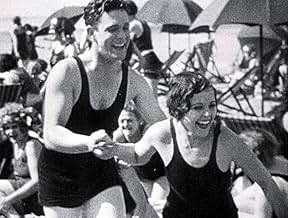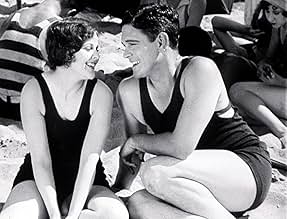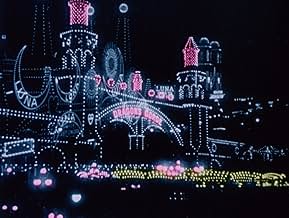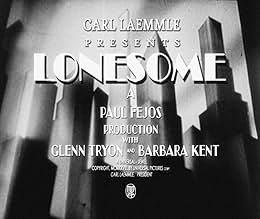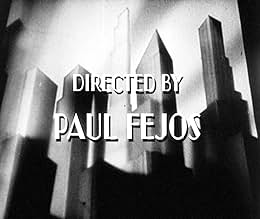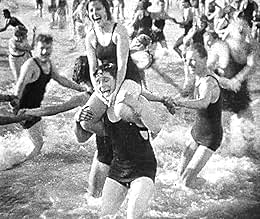VALUTAZIONE IMDb
7,7/10
2818
LA TUA VALUTAZIONE
Aggiungi una trama nella tua linguaTwo lonely people in the big city meet and enjoy the thrills of an amusement park, only to lose each other in the crowd after spending a great day together. Will they ever see each other aga... Leggi tuttoTwo lonely people in the big city meet and enjoy the thrills of an amusement park, only to lose each other in the crowd after spending a great day together. Will they ever see each other again?Two lonely people in the big city meet and enjoy the thrills of an amusement park, only to lose each other in the crowd after spending a great day together. Will they ever see each other again?
- Regia
- Sceneggiatura
- Star
- Premi
- 1 vittoria in totale
Gusztáv Pártos
- Romantic Gentleman
- (as Gustav Partos)
Henry Armetta
- Ferris wheel guy
- (non citato nei titoli originali)
Edgar Dearing
- Cop
- (non citato nei titoli originali)
Louise Emmons
- Telephone Caller
- (non citato nei titoli originali)
Fred Esmelton
- Swami
- (non citato nei titoli originali)
Jack Raymond
- Barker
- (non citato nei titoli originali)
Churchill Ross
- Telephone Caller
- (non citato nei titoli originali)
Recensioni in evidenza
... and I could say the same thing about Fejos' "Broadway", made a year later. Fejos recounts the tale of two lonely New Yorkers, Jim (Glen Tryon) and Mary (Barbara Kent), who find love and each other during a half day holiday at the beach and Coney Island. You first see the workday from Jim and Mary's perspective as they are ruled first by the tyranny of the alarm clock and then the tedium of the workday as you see a clock overlaying the image of each at work. Jim is a low-level machine operator, and Mary is a telephone operator. Then there are "the crowds". Jim and Mary are crowded at breakfast, at a diner filled with patrons, crowded on the subway, crowded at work, and crowded at the beach and amusement park. Yet both of them are completely alone in the world, which, especially in the attractive Miss Kent's case, seems somewhat inconceivable.
This late era silent has a dearth of title cards, which does not subtract from the film's enjoyment. In fact, what does subtract just a little are the short dialogue scenes that just don't make sense. One scene is Jim and Mary on the beach suddenly in the dark AND in color, with the crowd removed. Nothing they say shines any light on their situation or feelings at all. Another one is in a courtroom where Jim has been detained for being unruly. He gives a speech like a Bolshevik basically shaming the judge and ... the judge lets him go???? This social awareness seems very strange stuff coming from Jim who, up to that point, has seemed to be a very uncomplicated fellow. Very strange, but typical of talking scenes inserted into silent films at the dawn of sound.
What is extra special about this film is to see the lives of working class people in 1928. Notice that the workday that Jim and Mary are going through is a Saturday, and this was the norm back then and until some time after WWII. People would normally work half a day on Saturday and have only Sunday in its entirety as a day off. Catch this film if you can, even if you are not a huge silent film buff.
This late era silent has a dearth of title cards, which does not subtract from the film's enjoyment. In fact, what does subtract just a little are the short dialogue scenes that just don't make sense. One scene is Jim and Mary on the beach suddenly in the dark AND in color, with the crowd removed. Nothing they say shines any light on their situation or feelings at all. Another one is in a courtroom where Jim has been detained for being unruly. He gives a speech like a Bolshevik basically shaming the judge and ... the judge lets him go???? This social awareness seems very strange stuff coming from Jim who, up to that point, has seemed to be a very uncomplicated fellow. Very strange, but typical of talking scenes inserted into silent films at the dawn of sound.
What is extra special about this film is to see the lives of working class people in 1928. Notice that the workday that Jim and Mary are going through is a Saturday, and this was the norm back then and until some time after WWII. People would normally work half a day on Saturday and have only Sunday in its entirety as a day off. Catch this film if you can, even if you are not a huge silent film buff.
8sb88
It's a shame Lonesome hasn't been seen more widely by modern audiences. The limited acclaim it's received is well deserved.
Lonesome is very simple. It's no more than a little romantic movie of two people who fall in love and then appear to lose each other. But the whole thing is told expertly well. The camera moves about freely in many unique and interesting ways. Visually alone, it's quite the spectacle. It also helps that the two in the lead roles are enjoyable.
Glenn Tyron is good enough in his lead role, but his romantic interest, played by Barbara Kent, is the real star. She is fun and playful when needed, but her soulful eyes convey more pain then most people ever could with their voices. Her charisma is evident from shot one.
The only downside to the film is the inclusion of a few sound scenes. Clearly done just to cash in on the new craze, it actually only serves to grind the story to a halt. It forces the movie to become stationary, and the dialogue itself is pretty inane.
I cannot recommend the film strongly enough, though. It's as enjoyable of a romance as you'll ever see. There's nothing too complicated here: just two people falling in love, and it's a joy to see.
Lonesome is very simple. It's no more than a little romantic movie of two people who fall in love and then appear to lose each other. But the whole thing is told expertly well. The camera moves about freely in many unique and interesting ways. Visually alone, it's quite the spectacle. It also helps that the two in the lead roles are enjoyable.
Glenn Tyron is good enough in his lead role, but his romantic interest, played by Barbara Kent, is the real star. She is fun and playful when needed, but her soulful eyes convey more pain then most people ever could with their voices. Her charisma is evident from shot one.
The only downside to the film is the inclusion of a few sound scenes. Clearly done just to cash in on the new craze, it actually only serves to grind the story to a halt. It forces the movie to become stationary, and the dialogue itself is pretty inane.
I cannot recommend the film strongly enough, though. It's as enjoyable of a romance as you'll ever see. There's nothing too complicated here: just two people falling in love, and it's a joy to see.
A sister of Sunrise and The Crowd, this film is more emotional and poetic than those landmarks and every bit as great. The plot concerns two working class American types, he works in the factory, she works on the intercom who meet by chance on a fairground and fall in love and then lose each other without knowing where the other lives.
The film's beginning is to be treasured, it follows in detail the morning ritual of first the girl and then the man in their respective homes. The effect conveyed is the organization and elegance of women over the tardy, rushed, half-baked activities of men. The love story between the two characters is so beautifully etched and played so naturalistically by the actors(Barbara Kent and Glenn Tryon) that the sense of loss in the latter half of the film is all the more painful and heart-breaking. The film deals with a certain truth about living in a city that has remained constant even after a good 80 years. At once a constant sense of community and at other an equally constant sense of loneliness from being in a crowd.
The film's beginning is to be treasured, it follows in detail the morning ritual of first the girl and then the man in their respective homes. The effect conveyed is the organization and elegance of women over the tardy, rushed, half-baked activities of men. The love story between the two characters is so beautifully etched and played so naturalistically by the actors(Barbara Kent and Glenn Tryon) that the sense of loss in the latter half of the film is all the more painful and heart-breaking. The film deals with a certain truth about living in a city that has remained constant even after a good 80 years. At once a constant sense of community and at other an equally constant sense of loneliness from being in a crowd.
10clanciai
The striking character of this film is its extreme intensity in a fantastic camera work that keeps rushing on in breathless frenzy to the very bitter end of the film. It's almost like a documentary in its constant flow of following the crowds from the working places to the reckless carneval of Coney Island, never leaving the strenuous hard pace of life for one second, except for the moments when the lovers find each other. Then there is a touch of poetry, which also marks the film with a totally different character, which makes it doubly interesting. This film is like no other film, the closest in likeness is actually Eisenstein's "Battleship Potemkin" which also wallows in following the crowds in wild frenzy, but here the lovers provide some privacy and individualism, which is totally missing in Eisenstein's masterpiece, and this is certainly a masterpiece of the same rank but on a different level, for its very human touch of simplicity and basic togetherness. There are also some resemblance to Fritz Lang's "Liliom" with Charles Boyer, which also renders the carneval and wild pleasure hunting in frenzied rush of popular festivity in unforgettable cinematography.
Paul Fejos made many documentaries, he was a master and genius in observing and capturing life at its most original and basic level, his documentaries are from Madagascar, South East Asia, Peru apart from Europe and America, he made altogether 44 films, and this is just an example of his extremely personal and highly advanced art of the film.
Paul Fejos made many documentaries, he was a master and genius in observing and capturing life at its most original and basic level, his documentaries are from Madagascar, South East Asia, Peru apart from Europe and America, he made altogether 44 films, and this is just an example of his extremely personal and highly advanced art of the film.
There are at least three levels at which 'Lonesome' is an extremely interesting film.
1. It is a sweet story of two lonely people in a big anonymous city who meet, fall in love and lose each other. The picture is well-acted, and the two lead actors Barbara Kent (Mary) and Glenn Tryon (Jim) are perfectly matched; they both give nuanced and sensitive performances.
2. The style of the picture is almost documentary, which makes it interesting from a social history point of view. In some ways, nothing much has changed over the last 100 years: People are still commuting to work, the subway in New York was as crowded as the London Underground is today (I don't know about New York in 2022), you get annoyed at the same kind of behaviour of your fellow passengers (e.g. Eating smelly food) etc. Obviously other things have changed: The type of work we do, for example, and we no longer bond over serialised novels published in newspapers that we read. Nevertheless, we are still living in what is recognisably the same kind of society. I found this aspect of 'Lonesome' particularly interesting.
3. Technologically, 'Lonesome' was highly innovative, being the perfect example of a film that came out during the transition phase from silent pictures to talkies to colour films. Initially, it looks like a normal black and white silent film to which music and some sound effects have been added. However, some scenes have spoken dialogue, and some are even in colour, or at least partly colorised. People back then must have felt they were living in an exciting age of innovation; I am sure they expected that within the next few years, all talking and maybe even all colour films would become the norm.
So why am I giving 'Lonesome' no more than 8 stars? Well, there are a few flaws. First, the dialogue sounds as stilted as if the actors were reading it from a sheet, and on top of that, a bit of it does not seem to make much sense (the scene at the police). It feels like an afterthought, like something director Pal Fejös inserted after having finished the rest of the film. Second, the colour effects are not particularly nice to look at. The colours are just garish. They were certainly innovative, but the film would look better without them. And finally, the plot is so simple that it barely exists. The only real problem the characters face appears almost at the end of the film, and its resolution does not logically follow from anything that happened earlier; it just comes about by chance. I am reserving 9 stars for pictures that are as good as perfect, and 10 for those that have some particular emotional quality or style that takes them into the small group of my favourite films (like e.g. 'North by Northwest', which for my taste must be one of the most stylish films ever made). 'Lonesome' is very good, but not as good as that. Hence 8 stars.
1. It is a sweet story of two lonely people in a big anonymous city who meet, fall in love and lose each other. The picture is well-acted, and the two lead actors Barbara Kent (Mary) and Glenn Tryon (Jim) are perfectly matched; they both give nuanced and sensitive performances.
2. The style of the picture is almost documentary, which makes it interesting from a social history point of view. In some ways, nothing much has changed over the last 100 years: People are still commuting to work, the subway in New York was as crowded as the London Underground is today (I don't know about New York in 2022), you get annoyed at the same kind of behaviour of your fellow passengers (e.g. Eating smelly food) etc. Obviously other things have changed: The type of work we do, for example, and we no longer bond over serialised novels published in newspapers that we read. Nevertheless, we are still living in what is recognisably the same kind of society. I found this aspect of 'Lonesome' particularly interesting.
3. Technologically, 'Lonesome' was highly innovative, being the perfect example of a film that came out during the transition phase from silent pictures to talkies to colour films. Initially, it looks like a normal black and white silent film to which music and some sound effects have been added. However, some scenes have spoken dialogue, and some are even in colour, or at least partly colorised. People back then must have felt they were living in an exciting age of innovation; I am sure they expected that within the next few years, all talking and maybe even all colour films would become the norm.
So why am I giving 'Lonesome' no more than 8 stars? Well, there are a few flaws. First, the dialogue sounds as stilted as if the actors were reading it from a sheet, and on top of that, a bit of it does not seem to make much sense (the scene at the police). It feels like an afterthought, like something director Pal Fejös inserted after having finished the rest of the film. Second, the colour effects are not particularly nice to look at. The colours are just garish. They were certainly innovative, but the film would look better without them. And finally, the plot is so simple that it barely exists. The only real problem the characters face appears almost at the end of the film, and its resolution does not logically follow from anything that happened earlier; it just comes about by chance. I am reserving 9 stars for pictures that are as good as perfect, and 10 for those that have some particular emotional quality or style that takes them into the small group of my favourite films (like e.g. 'North by Northwest', which for my taste must be one of the most stylish films ever made). 'Lonesome' is very good, but not as good as that. Hence 8 stars.
Lo sapevi?
- QuizIt was one of the first motion pictures to have sound and a couple of talking scenes. It was released in both silent and monaural versions. Some scenes in existing original prints of the film are colored with stencils.
- Versioni alternativeProduced in both sound and silent versions. The sound version was 6,785 feet in length, and the silent version was 6,193 feet.
- ConnessioniFeatured in Fejezetek a film történetéböl: Az amerikai film kezdetei (1989)
- Colonne sonoreAlways
(uncredited)
Written by Irving Berlin
[Played by dance orchestra at ballroom]
Sung by Nick Lucas
[on Brunswick recording played in last scene]
I più visti
Accedi per valutare e creare un elenco di titoli salvati per ottenere consigli personalizzati
- How long is Lonesome?Powered by Alexa
Dettagli
- Tempo di esecuzione
- 1h 9min(69 min)
- Mix di suoni
- Proporzioni
- 1.19:1
Contribuisci a questa pagina
Suggerisci una modifica o aggiungi i contenuti mancanti



